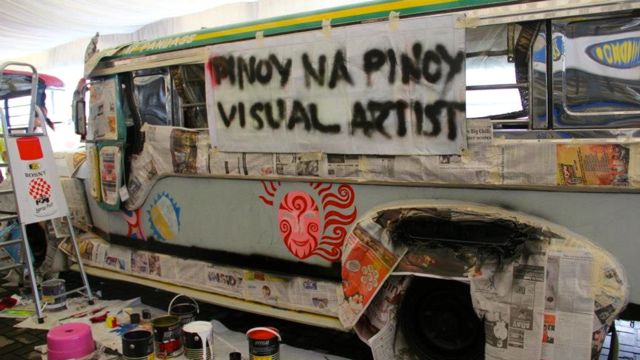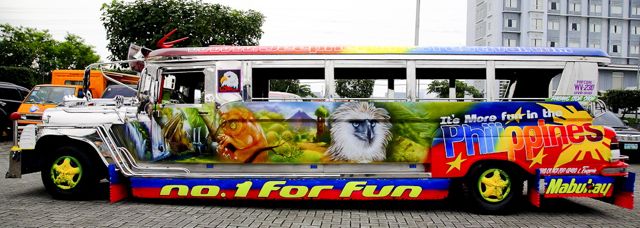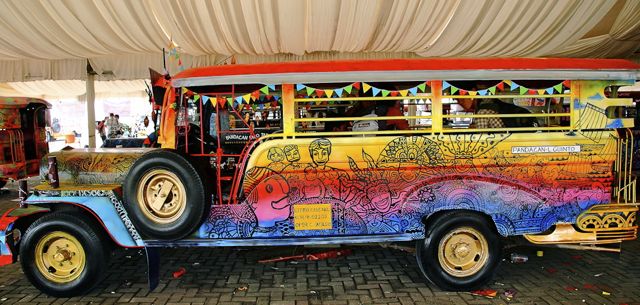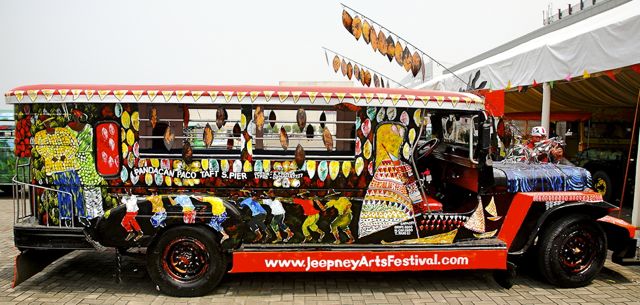SUMMARY
This is AI generated summarization, which may have errors. For context, always refer to the full article.

MANILA, Philippines – For those blaming the heavy traffic on the Filipino jeepneys and wishing they disappear completely: there’s probably a long way to go.
On busy thoroughfares, they’re still snaking through crowded traffic, letting passengers on and off at the most random stops.
You can hear them: their noisy motors, their barkers screaming their destinations and urging the people to squeeze into their already-packed metal contraption.
And you can smell them too: diesel-laden fumes filling the air.
The jeepneys have long been dismissed as a necessary, annoying and even dangerous part of city life. An accident-waiting-to-happen on wheels.
Clang Garcia refuses to see them this way.
The jeepney as a Pinoy culture icon

Clang operates Jeepney Tours, an enterprise that exploits the jeepney’s cultural reputation.
Its hop-on, hop-off programs, she explains, are inspired by those existing abroad.
“I thought, how come we don’t have that kind of service in the Philippines?” Clang shares. “So I thought of bringing the concept here. It’s not new — but I wanted to present something local.
“I thought of capitalizing on a local icon, which is the jeepney.”
These special jeepneys are supersized in features.
They’re decked out with air-conditioning, karaoke and extra wiggle room — the seats are composed of front-facing rows that can comfortably fit up to 20 passengers as opposed to two rows facing each other squeezing 8 people on each.
Overall, the changes (and the tour packages) are impressive.
They’re also not — at the heart of it — very authentic.
Because who would want to put any tourist in a public vehicle with cryptic routes and dare him to echo the tourism department’s slogan, “It’s More Fun in the Philippines”?
This may be fun for the adventurous types, but there must be better options for the adrenaline-seekers.
So, instead, the jeepney is left to be romanticized topics of conversations, subjects of artistic (or art-filtered) photos and topics of academic treatises. They’re all very interesting — from afar.
And up close? They’re subjects of complaints, mostly.
Yes, the jeepney is our cultural fallen hero.
The accidental advocate

This curious case of the jeepney is conveniently in the realm of all-talk, no-action; a safe space where everyone theorizes and not much more.
But Clang was restless and unimpressed with the complacency. Why not, she thought, create an event that would gather artists to bring back the flashy, colorful heydays of the beloved jeepney?
Thus, the Jeepney Arts Festival was born.
It’s a dream project that, for her, shows the role of the jeepney in our heritage. She insists, “[The jeepney] is the real cultural icon for Filipino artistry, resiliency, entrepreneurship, ingenuity,” she claims.
“We have to find a way to revive it.”
It’s a tall order for what was once the most celebrated vehicle on the streets, and today’s often-regarded has-been cultural icon.
Art, tourism and bayanihan

The idea is as grandiose as its premise is simple.
50 jeepneys were to converge in a parking lot at SM Mall of Asia, one of Manila’s biggest shopping malls. 3 are from Clang’s Jeepney Tours and 47 are public passenger jeepneys. Artists come in to paint a tourist destination on each and if their jeepney is the best of the 50, they win a cash prize.
Easy enough, right? Well, not exactly.
It’s a new ballgame to knock on local government units asking for support. It has proven to be an even larger task to drum up enthusiasm from locals as opposed to inbound business from foreigners.
See, Clang is an entrepreneur, not your usual social good advocate. The fact that she is a businesswoman and Jeepney Tours is not an NGO nor a social enterprise have become the project’s own stumbling block.
Her fervor was often met with suspicion or dismissed as a lost cause.
Many found the idea far-fetched, even futile. Clang faced and battled doubts.
But one thing kept her focus on the goal. It’s a word she mentions often: bayanihan — a trait Filipinos are proud to have and roughly translates to community spirit.
“You have to do something beyond you. For your community, for your country.” She pinned her hopes on this, as dreams don’t come cheap.
“[The project] is expensive. I cannot do this alone.”
From vision to transformation

On the festival’s 3 days, rows upon rows of jeepneys were parked, the drivers gone, the metal carriages bare.
Meanwhile, the jeepney drivers attending were given seminars on courtesy and social graces, placing their trust in Clang’s vision. Before that, they had to ensure that their vehicles passed smoke emissions testing. The approach to transformation was to happen in a comprehensive manner.
It took some convincing, however, with concerns boiling down to the daily wage: the drivers, after all, still needed to take pay home to their families.
The festival took care of drivers’ wages, acknowledging that the problem with jeepneys is more than skin deep. Helping the icon meant extending a hand to everyone involved.
On site, Clang’s earlier fear of not having enough support eventually proved to be unfounded.
Students, artist groups and all sorts of visual creatives trooped to the venue. The artists started to arrive, initial sketches were imposed, paint fumes filled the air.
Sponsors provided paint. Media found the idea newsworthy.
On the road to change

“It was overwhelming,” she recounts a couple of days after it was over.
After facing several closed doors, she is now facing avenues from all directions.
She shares, “More people and companies are ready to ride the campaign bandwagon! There were companies and local government units who turned us down, then went to visit the site, and were fascinated by it. They have offered to be a part of it next year. A company approached us to do it nationwide!”
It’s good news for Clang. It allows her to indulge in the big picture that she has painted for the Philippine jeepney.
For her, the Jeepney Arts Festival is a “gateway to create awareness and appreciation about [the] Philippine jeepney.”
In fact, she also issues a challenge: “Imagine if all the Fine Arts students would paint a Filipino jeepney, how beautiful Manila will be. [The jeepney will be] a roving museum of arts and culture.
“If Engineering students can design a jeepney for their own generation, what would it be?
“[For local government units], it can be a roving billboard for them.”
Green fuel, double decker designs, electric engines are ideas being thrown around. Clearly, there is a lot that can be done to push the campaign for the jeepeney’s rehab.
The test would be on the road, however. After the paint job and the parade where they shocked Manila traffic, where have these brand-spanking-new jeepneys gone?
“They’re back in their original routes,” Clang reports. “It’s funny — the drivers have allocated a special lane to park the jeepneys. Suddenly, their newly-painted jeepney are priceless treasures and they are now taking care of it well.”
Maybe one day, who knows, we’ll be singing the jeepney actual praises.
Instead of locking them in the past, with collaborative efforts, we can help recreate them as an innovatively practical, visually delightful icon that leads the way forward. – Rappler.com
Add a comment
How does this make you feel?
There are no comments yet. Add your comment to start the conversation.